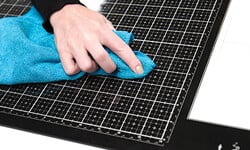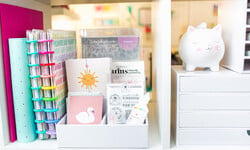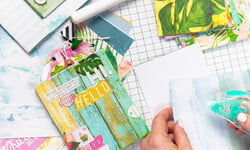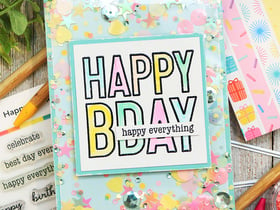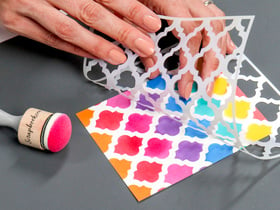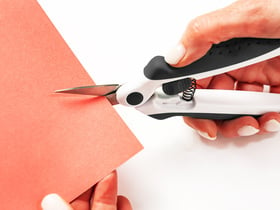This article was written by Jill Davis. It uses some methods developed by Stacy Boatman. With her permission and help, we've included her concepts and experiences.
Materials Needed To Brainstorm Your Dream Studio
Your creative brain, a camera to document your organizational process from start to finish, a computer to post these photos, and a notebook and pen to jot down your thoughts as you move along.
The Challenge
To dream about your ideal studio, find a solution for one problem area, take photos, and begin to take charge.
Where to Start
Take a moment to fill out the Space Assessment Handout. This handout will help you to identify your problem areas. Your challenge after that will be to discover why these areas are hindering your scrapbooking experiences and what you can and will want to do to fix these problems. I also encourage you to take photos of your space and invite you to post one or two of them in the Get Organized Gallery. You can also view images from previous class participants in our Legacy Gallery. Also, give yourself a time limit in which your dream studio will completely organized.
Your first challenge will be to dream. Take a deep breath and leave your current world behind. While exhaling, say to yourself several times, "RELAX." Imagine you just woke up from 12 hours of uninterrupted sleep and you're refreshed. Now, head to your studio/space you're transforming into the craft headquarters of your dreams. You're welcomed by a red carpet that flows to magnificent French doors, which lead into your space. The glorious Scrap Fairy has been there, leaving you the place of your dreams! It's clean and free of dust and clutter. It's organized and only has tools and supplies you are looking forward to using.
Stay relaxed in this wonderful dream state; keep breathing deeply. What else do you see? Are tools and paper in country woven baskets, or are they in sleek metal tins? Are there labels on containers, or do you just "know" where every supply is? Are your bottles of paint lined up on a shelf in ROY G. BIV, or are they stashed in a drawer? Is your paper in racks, or behind cupboard doors? Does the space feel like the loft of a Manhattan artist, a cozy room in a southern cottage, or maybe like the porch of a beach house? This is YOUR dream room. There is no right and no wrong. This is the place you'll spend much of your time and creative energy, so start envisioning what you want. Remember, this is just brainstorming and dreaming, so let go of budget and space constraints. We'll deal with those later. For now, just have fun imagining the possibilities.
Now, let's move to reality and address the problem areas with confidence. Review your Space Assessment Handout and isolate the first problem area. Think about it and write down every thought that might come to you: Why it's a problem, what would make it easier, and how can you improve it? Remember, your dream space has no problems and we're aiming for a real space that is full of solutions. Envision yourself in the space, creating a crafting masterpiece.
Let's take a look at an example of what a person might experience during this process if purchased kits were the first problem noted on his or her Space Assessment Handout. Suppose this person's kits were stored in plastic bags, and all bags were lined up on a desk, pushed back against the wall; when one was removed, the rest fell over. In a dream space, there would be a way to keep the bags upright, in order, and off the desk. Maybe upright. Perhaps the bags could hang from the skirt hangers on a road attached to the wall or in a closet. All of these options could work, or maybe one would work better for you. Are you getting the picture of how fun and easy it is to dream, wish, and hope?
If an organizational problem arises that you feel cannot be currently addressed, fear not! All areas of organizing a studio are covered in Scrapbook.com's free class, Get Organized. If a related organizational problem shows up, this class will hold solutions and ideas. For example: If kits showed up as a problem on your Space Assessment Handout, jot down kit organization possibilities. Then, review Lesson #8 in Get Organized, where you may find something related to hanging or using upright containers for kits that will work for you. However, it is always helpful to jot down ideas and thoughts now so that you'll have a good start with how to fix the problem later. If you can't think of any solutions, that's okay too. Leave that area blank and know you'll fit it in as time progresses.
Please don't address budget and space constraints yet (I know that might be a concern). Instead, focus on one practical aspect of scrapbooking: How you work. I know many in this challenge have seen beautiful scrap rooms they'd sacrifice for. However, those spaces you long for might not be what are best for you. If you have small children who get into everything, open shelves at kid eye-level are not going to work for you, no matter how pretty they are or how much you love them. You and your children will just get frustrated with that option. If you have one small surface to work on, don't drool over a desktop tool caddy that will take up half of that space. If you're a sitting scrapper, don't look into counters that will require you to stand as you work. Keep your habits, likes, dislikes, and reality in mind. You CAN have a fabulous space! One based on your own terms, where you will also enjoy working.
Someday, you can own the things you would like to. However, I want you to rule out any storage solution that won't work in your space, no matter how appealing or pretty. If something won't work in your space, keep it on a wish list and stick to what does work for now.
Staying Enthused
The final challenge will be to take pictures of your space as it is. I think this is a great motivational tool. It's not meant to discourage you, but rather to enlighten. I'd like to invite you to post a photo or two in our gallery. By doing so, you're going to find that there are spaces out there much, much worse than yours. And this fact will (sadly) boost your spirits.

If you have the absolute worst space posted, well... You have nowhere to go but up, right? Keep attitudes positive and be careful with comments. If someone is brave and posts, then they are just that... BRAVE! Also, please print out your photos and display them prominently in your space. Why? Because, as you progress through this organizational process, you're going to look at the picture(s) and see how far you've come. That will give you the boost you need to keep going.



Stacy's Space
Overall, Stacy is happy with her space. She's able to clear any counter or island clutter quickly and easily because there are designated containers and places for everything. Her space was constructed from the ground up, so she was able to fix problems as she built out the space. This is the space of her dreams.
My Experience
This is a photo of my dreams coming together:

Halfway through the sorting and organizing process, I hit a roadblock. I got sick, and it took a long time before I felt good enough to do anything. I was also low on patience with the clutter I couldn't get to, and fell behind with the challenge. If you look at the photo, there is both clutter and organizing going on at the same time on the work surface of my island. On this day, I decided to move everything that needed sorting and organizing onto the landing outside of my studio. I also put boxes full of things into a corner of our bedroom. This emergency clean-up was a big mistake, and you'll learn why next week. I truly thought I could get the whole thing cleaned up in a day, ha! It took months!
During these months, I also struggled with new decisions; questioning everything about old and new organizational systems. I wanted my room to be completely organized, full of creativity and have a "flow." I read a book about Feng Shui to better understand how clutter affects our beings and homes. I studied and then incorporated simple parts of practice into my studio. This was just what was needed to stop my doubts, make the space flow and for me to see how to organize every little thing. The space became comfortable to me and to others. Feng Shui principles may not be for everyone, but they sure helped me. One example, I often left large items on the floor to deal with later (see the photo above). I did this for convenience, but it became clutter. When I cleaned EVERYTHING off of the floor (even things under my island), I felt free, and every nook and cranny that I cleaned up after that brought more freedom.
I was in a meeting with my co-worker and she mentioned that scrappers are either "diggers or separators." I asked what she meant and she said that she prefers one container for buttons so she can rummage through it to find what she needs; hence, a digger. We talked about the separator (or sorter) who would remove buttons from cards, sort them into groups of color or type, and then place them into individual containers. Grateful for new insight, I looked at my studio and habits. I concluded I'm a digger in some of my organization systems, and a separator (or sorter) in others. For example, my embellishments are separated into color-coded bins where I "dig" into them to find what I need (they're not in one huge bin like a true digger). I like my buttons in separated color-assigned jars where I can find them quickly like a sorter. This concept helped me focus on what I usually did when I scrapped, when I brought something home from the store, or when I cleaned up. The work I did on the challenge became more fun with my systems clearly defined. I also found if I over-did my sorting, I ended up spending more time sorting than if I dug for something occasionally. In the end, the systems I (and you) implement are the systems we will want to use. No one cares as much as we do about our studios and how we create in them.
Tip: Consider the digger, separator, or a combination of the two as you approach your systems and when dreaming about your space. It might reveal new thinking about your scrapbooking preferences that you hadn't considered before.
As I sorted, I became aware that I had a lot of "collections" that burdened me. I had too many things in some of my centers which made it difficult to remember what I had, let alone to remember to use them. Here's one example: Gripper punches that punched a small flower, teardrop, oval, pine tree, etc. were popular in the late 90s. I had developed a collection of them and realized during sorting that, while I felt comfortable knowing I had most of the punches to use if I needed, I rarely used all of them (only the circles and rectangle). Theses punches were some of the first tools I ever owned, and I was emotionally attached to them. They had served me well, but took up prime real estate in my space. I put most of them into a box and gave them away. What a relief! After that experience I challenged myself to honestly assess everything in my space and let go of any item or collection that didn't serve my needs or was burdensome. It was one of the most liberating things I've done for myself (and my studio) in years.
I was tempted to go to the Container Store or Dollar Store and buy containers, bins, or storage items to temporarily hold stacks of things I was sorting. Instead, I saved money by waiting. I used paper bags from the grocery store to hold stacks of things being organized. They stood upright as I filled them, and then folded down and were all but out of sight when empty--until I needed them for the next area of focus.

Summary
A photo of my old space kept me focused on my dream space during the work phases of this challenge. Looking at a before photo as we work can help us focus on what our space is becoming and it can uplift us. Working from the Space Assessment Handout brings solutions for problem areas and bring feeling of success each time something is checked off. You'll be amazed how your space will come together, and that you can live and even be happy through the chaotic sorting times. Our "before" photos can be great motivators to help us be vigilant in keeping organizational systems clutter-free maintained.

If you are looking for more information on organizing your craft space, check out these two informative articles here and here.
This article is part of our free class called Get Organized. To further elaborate on your craft space organizational skills, sign up and take the class for free here!















